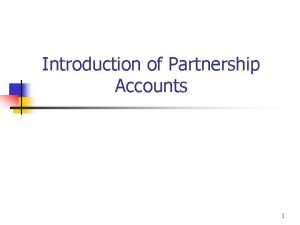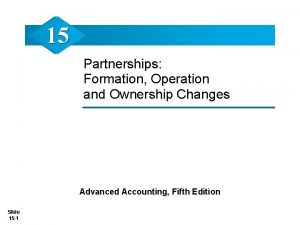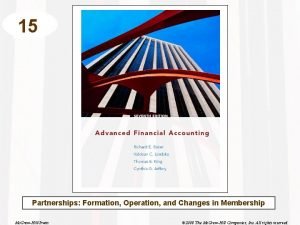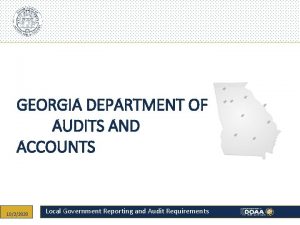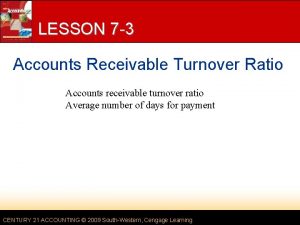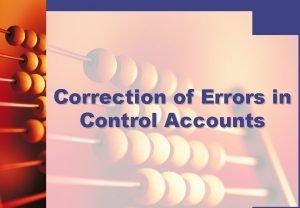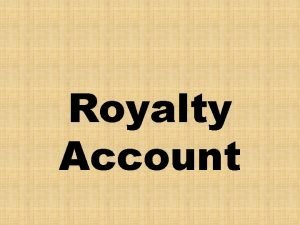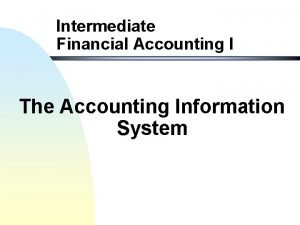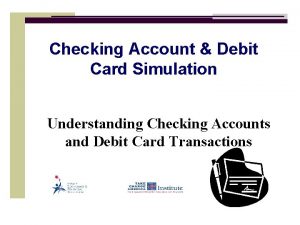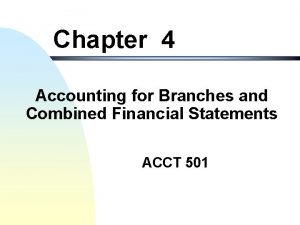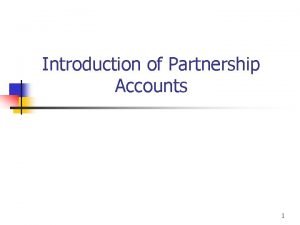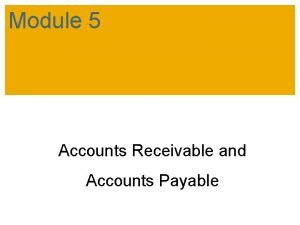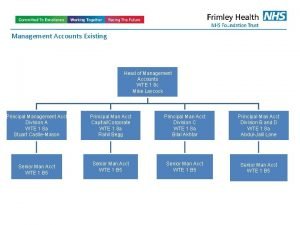6 PARTNERSHIP ACCOUNTS FORMATION OF A PARTNERSHIP s



























- Slides: 27

6 PARTNERSHIP ACCOUNTS

FORMATION OF A PARTNERSHIP s Defined in the Partnership Act 1890 as the relationship between two or more people engaging in business for profit 2

FORMATION OF A PARTNERSHIP s Three important factors must be present in a partnership: Ùpartners must be carrying on a business, not one isolated business transaction Ùmust be agreement between two or more legally competent people who must be the business coowners Ùpartners must have intent to make a profit 3

FORMATION OF A PARTNERSHIP s Partnerships are separate accounting entities to the partners (owners) s Owner’s Capital Accounts are kept for each individual partner s Each partner has the right to share in the profits and manage the business 4

PARTNERSHIP AGREEMENT s Partnership agreement Ùdoesn’t always exist, making it difficult to establish if a partnership actually exists Ùif there is no formal partnership agreement then the Partnership Act applies Ùagreement is essential because partnerships: xhave unlimited liability xhave a limited life • death of partner • insolvency of partner • retirement of partner 5

PARTNERSHIP AGREEMENT name of business details of each partner nature of business division of profit and losses s capital contributions s authority, rights and duties of partners s details of salaries s s drawings and interest on drawings s interest on capital s voting and decisionmaking procedures s admission of new partners s resolution of disputes s bankruptcy, death or retirement of partners 6

PARTNERSHIP ACT 1890 s If there is no partnership agreement in writing, or if it does not cover an area of dispute, matters may be resolved by reference to the Partnership Act Ù e. g. Act states all profits and losses are to be shared equally, so if profit ratio is not defined in an agreement, the Act is applied Ù Partners will receive interest at 5% on excess capital (ie over and above that which they have agreed to contribute) Ù No interest on drawings Ù No salaries 7

ADVANTAGES OF PARTNERSHIP s Creation and dissolution is easier than a company s Minimal statutory regulations s Resources can be pooled s Expertise can be utilised s Co-ownership of assets s Duties and responsibilities are shared 8

DISADVANTAGES OF PARTNERSHIP s Liability is unlimited (partners own personal possessions can be used to pay debts owed by the business) s Partnership may cease if a partner dies, retires or becomes bankrupt s Disagreements between the partners can occur s Limits to raising large amounts of capital s Partners can be sued by creditor, jointly or individually s Partners are likely to pay higher income tax 9

LIMITED LIABILITY PARTNER s Governed by the Limited Liability Partnership Act 1907 s Liability is limited to the amount of capital invested by the partner s A Limited Partner has no say in the Management of the Partnership business 10

PARTNERSHIP ACCOUNTS s CURRENT ACCOUNTS Ùworking accounts containing details of profit, loss, drawings and interest on capital invested or charged on drawings s CAPITAL ACCOUNTS Ùpartner’s original capital put into the business is considered to be ‘fixed’ Ùcapital account of each partner is usually unchanged unless additional capital is invested 11

PARTNERSHIP ACCOUNTS s CREATION OF NEW PARTNERSHIP ACCOUNTING ENTRIES ÙCan be created in two ways xthe introduction of cash only, entered in the cash account and the partner’s capital account xthe introduction of cash and other assets; entered in the cash and asset accounts and the partner’s capital account 12

PROFIT DISTRIBUTION s PROFIT-SHARING RATIOS ÙProfits and losses are shared in the way partners feel most appropriate ÙProfit share can be determined in various ways: x. Amounts are shared on the basis of the amount of capital contributed by each partner x. Higher profit may go to a partner bringing something of particular value into the business, such as specialised expertise 13

PROFIT DISTRIBUTION s PROFIT AND LOSS APPROPRIATION ACCOUNT ÙNet profit or loss is transferred to this account from the profit and loss account ÙAdditions are made for Interest on Drawings (this is to discourage partners from making drawings from the business) ÙDeductions are made for Interest on Capital or any Salaries paid to partners ÙResidual Profits are then shared, as agreed, according to Profit Sharing ratios 14

PROFIT AND LOSS APPROPRIATION ACCOUNT Profit and Loss Appropriation Account for Able, Bable and Cable Net Profit Add Interest on Drawings Less Interest on Capital Salary – Able Residual Profit: Shared: Able 1/3 Bable 1/3 Cable 1/3 £ 2, 500 £ 5, 000 £ 3, 000 £ 16, 000 500 16, 500 £ 7, 500 £ 9, 000 15

PROFIT DISTRIBUTION s ALLOCATION AS PER PARTNERSHIP AGREEMENT ÙInterest on capital may be payable ÙInterest may be charged for drawings taken out of the business ÙThere may be a provision for the payment of a salary of a particular partner ÙInterest may be payable on loans to partners by the business or loans by partners to the business 16

PROFIT DISTRIBUTION s LOAN ACCOUNTS ÙWhere a partner makes a loan to the business, the debit is to bank and the credit to loan account in that partner’s name s DRAWINGS ÙWhere a partner withdraws cash from the business in anticipation of profits earned, the current account is debited and cash/bank is credited 17

ADMISSION OF NEW PARTNER s REASONS FOR A NEW PARTNER ÙMay bring in new products and/or customers to the business ÙMay bring specialised expertise to the business ÙAllows the business access to further capital ÙMay bring in additional assets ÙMay provide new business contacts ÙMay be a requirement due to death, retirement or bankruptcy of an existing partner 18

ADMISSION OF NEW PARTNERSHIP AGREEMENT s ADJUSTING THE EXISTING BUSINESS ÙAll existing partners must agree on the admission of a new partner ÙAssets of the business should be revalued before a new partner is admitted ÙLiabilities need to be reviewed for accuracy in valuation ÙGains and losses to existing partners from new business value will be made at the existing profit -sharing ratio 19

STEPS TO ADMIT NEW PARTNER 1. 2. 3. 4. Review value of assets (see later slide) Consider inclusion of goodwill (see next slide) Record changes in the Ledger Accounts Open a Goodwill Account and adjust the existing partners Capital Accounts according to their existing profit-sharing ratio 5. Prepare opening ledger entries for new partner 6. Calculate partners’ new profit-sharing ratio 7. Prepare a new Statement of Financial Position ie Balance Sheet 20

ADMISSION OF NEW PARTNER s GOODWILL ÙGoodwill can be defined as future benefits from assets that cannot be individually identified e. g. reputation, customer database, management ability, product, location ÙGoodwill is an asset and as such appears in the Balance Sheet as an Intangible Asset ie one which cannot be seen 21

Recording Goodwill s When the partnership is revalued: ÙDebit the Goodwill Account with the value of the increase in the value of the business (premium) ÙCredit the existing partners Capital Accounts according to their profit-sharing ratio 22

REVALUATION OF ASSETS s Before admitting a new partner to the business, the Assets should be revalued: ÙSome eg Buildings may have appreciated in value ÙSome eg Machinery may not be worth as much as the Net Book Value in the Balance Sheet – perhaps insufficient amounts for depreciation has been written off over the years 23

Accounting for Revaluation s Adjustments to the relevant accounts should be made ÙEg If Buildings have appreciated, the Buildings Account would be Debited and the Revaluation Account Credited ÙIf there has been insufficient depreciation written off machinery, the Machinery depreciation account would be credited and the Revaluation Account Debited ÙThe balance on the Revaluation Account would then be transferred to the Partners Capital Accounts according to their profit-sharing ratio 24

PARTNERSHIP DISSOLUTION s REASONS FOR DISSOLVING A PARTNERSHIP ÙPartner(s) may give notice of intention to dissolve ÙInsolvency of a partner ÙOwnership changes e. g. converting to company ÙInability to trade profitably ÙDeath of partner ÙVoluntary agreement by partners ÙCourts may also rule to terminate the partnership 25

KEY TERMS You should be aware of the following terms when dealing with Partnerships and be able to give clear definitions as well as know how to account for each: s s s Capital Accounts Capital Adjustment Account Current Account Revaluation of Fixed Assets Fixed Capital Account 26

KEY TERMS s s s Interest on Capital Interest on Drawings Partnership Act Partnership Agreement Profit and Loss Appropriation Account Profit-sharing Ratios 27
 Introduction to partnership accounts
Introduction to partnership accounts Partnership formation and operation
Partnership formation and operation Partnership formation and operation
Partnership formation and operation Partnership formation and operation
Partnership formation and operation Partnership formation and operation
Partnership formation and operation Partnership s
Partnership s Formation initiale vs formation continue
Formation initiale vs formation continue Nostro vostro and loro accounts
Nostro vostro and loro accounts 30-10-2 ocga
30-10-2 ocga Mfo/pap meaning
Mfo/pap meaning Recievable turnover
Recievable turnover Accounting error detection
Accounting error detection Consumables on hand
Consumables on hand Mybill oregon state
Mybill oregon state Www.ephillips66.com
Www.ephillips66.com Pcc payment plan
Pcc payment plan Sodexo accounts payable
Sodexo accounts payable Student accounts hampton university
Student accounts hampton university Ima accounting meaning
Ima accounting meaning Royalty accounts journal entries
Royalty accounts journal entries Dr cash cr accounts receivable
Dr cash cr accounts receivable The expense recognition principle aims to record
The expense recognition principle aims to record Core elms sign in
Core elms sign in What is a secondhand account
What is a secondhand account Subsidiary ledgers meaning
Subsidiary ledgers meaning 3-1 savings accounts worksheet answers
3-1 savings accounts worksheet answers Sold services on account t chart
Sold services on account t chart Branch account journal entries
Branch account journal entries
